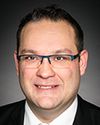Thank you very much. My apologies for the delays. We have extremely cold weather here in our region today, and that slowed everything down this morning. Thank you to IT for their help.
Hello members of PROC, fellow colleagues. I am pleased to be joining you today, along with my colleague, MP James Bezan, to present our objection to one part of the proposal made by the Manitoba Electoral Boundaries Commission, namely, the need to reinstate the Little Saskatchewan First Nation and the part of Lake St. Martin First Nation that was removed from the Churchill—Keewatinook Aski riding.
I want to begin by thanking the Manitoba Electoral Boundaries Commission for its hard and thorough work, evident in the report. I also want to note that we appreciate the boundaries commission's overall decision to not expand the Churchill—Keewatinook Aski riding. This was clearly a response to the serious concerns raised and the unanimous opposition of northern, indigenous and rural Manitobans regarding the proposal.
As you may already know, our riding is the fourth largest in the country. It includes 71 communities and is a riding with many challenges in terms of transportation, infrastructure, etc. The boundaries commission report decision to not move forward with its initial proposal reflected an understanding of the realities of first nations in northern and rural communities.
While the overall decision was one that made sense, the boundaries commission went ahead and proposed a problematic change to our riding that had nothing to do with the original proposal. It proposed removing one first nation in its entirety—Little Saskatchewan First Nation—and dividing and removing part of another—Lake St. Martin First Nation—and placing them into the Selkirk—Interlake—Eastman riding.
We object to this proposal on a number of grounds. First, this change was not part of the initial proposal. Therefore, Little Saskatchewan First Nation and Lake St. Martin never had the chance to be consulted on the specifics of this proposal, since it was never on the table. This is in opposition to the central importance of consultation with first nations.
Second, this change will cause confusion and likely lead to disenfranchisement. We must note that Little Saskatchewan First Nation and Lake St. Martin First Nation were part of the Selkirk—Interlake—Eastman riding prior to 2015, but so was the entire Interlake region. In 2015, all seven first nations in eastern Interlake became part of the Churchill—Keewatinook Aski riding. For seven years, much work has been done to inform and enfranchise citizens as to which constituency they are part of, where constituency offices and services are located, etc. Changing that for two of the first nations will contribute to confusion and even mistrust, given that they were not aware that this was even a proposal on the table.
It is problematic that Lake St. Martin First Nation is being divided, according to this proposal. This is a small community that has dealt with major upheaval in the last two decades, namely, the floods that led to the relocation of the community. Most people have moved back only since 2015. To then split up the community as part of this boundary redistribution would be to the detriment of the significant effort made by the community to restore stability and continuity.
Removing Little Saskatchewan First Nation does not make any sense either. Their three neighbour first nations, Pinaymootang First Nation, Dauphin River First Nation and Lake St. Martin First Nation, remain in Churchill—Keewatinook Aski. Reinstating Little Saskatchewan and part of Lake St. Martin into Churchill—Keewatinook Aski would also live up to one of the boundaries commission's guiding values of keeping communities of interest together.
Many people in Little Saskatchewan and Lake St. Martin have close family in their neighbouring communities that remain in Churchill—Keewatinook Aski. The first nations are part of the same overarching regional Interlake Reserves Tribal Council for both Little Saskatchewan and Lake St. Martin. Pinaymootang First Nation, which is the largest first nation in their area, is part of Churchill—Keewatinook Aski, and it is a hub for shopping, medical services, education, etc.
Finally, it is important to note that reinstating Little Saskatchewan First Nation and the part of Lake St. Martin that was removed from Churchill—Keewatinook Aski, if it were to be returned, would ensure that the population in our riding would still be under the limit.
As is evident from our joint presentation and joint objection, this is not a partisan issue. This is about respecting first nations. This is a gesture in the spirit of reconciliation. It is in line with the values of the boundaries commission. It is about enfranchisement, and it ensures that constituents, particularly those who are indigenous, who live in northern and rural communities, are treated with the respect they deserve.
We hope this change will be reversed, and I look forward to answering any questions you might have.
Thank you.









